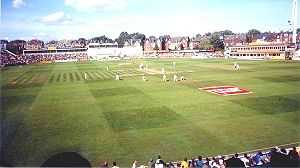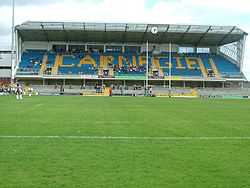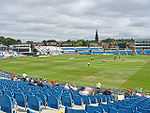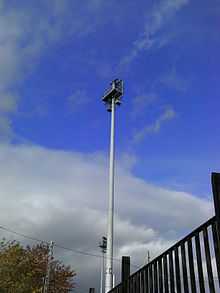Headingley Stadium

Headingley Stadium is a sporting complex in the suburb of Headingley in Leeds, West Yorkshire, England. It is the home of Yorkshire County Cricket Club, Leeds Rhinos rugby league team and Leeds Carnegie rugby union team.
There are two separate grounds with a two-sided stand housing common facilities. Initially owned by the Leeds Cricket, Football and Athletic Company, the ground is now managed jointly by Yorkshire C.C.C. and Leeds Rugby.[1]
Since 2006 the stadium has officially been known as the Headingley Carnegie Stadium as a result of sponsorship from Leeds Metropolitan University whose sports faculty is known as the Carnegie School of Sport Exercise and Physical Education.[2]
Headingley Carnegie Cricket Ground
 | |||
| Ground information | |||
|---|---|---|---|
| Location | Headingley, Leeds | ||
| Coordinates | 53°49′3.58″N 1°34′55.12″W / 53.8176611°N 1.5819778°W | ||
| Establishment | 1890 | ||
| Capacity | 20,000 | ||
| Owner | Yorkshire County Cricket Club | ||
| End names | |||
|
Kirkstall Lane End Football Stand End | |||
| International information | |||
| First Test | 29 June 1899: England v Australia | ||
| Last Test | 24–28 May 2013: England v New Zealand | ||
| First ODI | 5 September 1973: England v West Indies | ||
| Last ODI | 12 September 2010: England v Pakistan | ||
| Domestic team information | |||
| |||
|
As of 19 July 2008 Source: CricketArchive | |||
Headingley Carnegie Cricket Ground (usually shortened to Headingley) adjoins the rugby stadium through a shared main stand, although the main entrance to the cricket ground is at the opposite Kirkstall Lane end. It has seen Test cricket since 1899 and has a capacity of 17,500.
Notable sporting moments

In 1902, Yorkshire beat the touring Australians by five wickets, after dismissing them for 23 in their second innings with George Herbert Hirst and Stanley Jackson taking five wickets each.
Donald Bradman's innings of 334 in the 1930 Ashes Test included 309 runs on the first day, and he followed it in the Australians' next test at Headingley in 1934 with an innings of 304.
Spinner Hedley Verity took 10 wickets for 10 runs in 1932 for Yorkshire v Nottinghamshire, still the best bowling analysis ever in first-class cricket. Verity had also taken all ten against Warwickshire at Headingley in 1931.
In the 1948 Ashes series, Australia scored 404 for three on the last day to beat England. Arthur Morris scored 182 and Bradman scored 173 not out.
In the Third Test against New Zealand in 1965 John Edrich hit 53 fours and 5 sixes in his 310 not out. Captain M.J.K. Smith declaring before Edrich had a chance to pass Gary Sobers Test record 365 not out, and England won by an innings and 187 runs.[3]
In the third test match of the 1975 Ashes series (a four test series), early on Tuesday 19 August head groundsman George Cawthray discovered that campaigners calling for the release from prison of George Davis had dug holes in the pitch and poured oil over one end of the wicket, This led to the match being abandoned and declared a draw, denying England the chance to win back the Ashes.[4]
In the 1977 Ashes test, Geoff Boycott scored his hundredth first-class hundred. Four days later, by winning the same game, England won the series and regained the Ashes.
In the 1981 Ashes series, Headingley provided the stage for one of the most dramatic comebacks in Test cricket, when England beat Australia by 18 runs. Bookmakers had quoted odds of 500–1 against an England victory after they followed on 227 runs behind and then collapsed to 135 for seven in their second innings. However Ian Botham scored 149 not out, and then Bob Willis took eight wickets for 43, to give England an eventual 18-run victory. Two members of the Australian team had taken the 500–1 odds. This was only the second time in the entire history of Test cricket that a side had followed-on and won; something which would not occur again until 2001.[5]

In the Test of 1991, Graham Gooch scored a match-winning 154 not out, carrying his bat throughout England's second innings of 252, against the West Indies including Malcolm Marshall, Curtley Ambrose and Courtney Walsh.
In a game they had to win to stay in the 1999 Cricket World Cup, the eventual cup-winners Australia chased down South Africa's 271 for seven after being 48 for three. Steve Waugh, who had been dropped by Herschelle Gibbs as he attempted to throw the ball up in celebration, scored 120 not out.[6]
In 2000, England dismissed the West Indies for 61 to win by an innings and in two days, with Andrew Caddick taking four wickets in an over. England won again seven years later in 2007, as Ryan Sidebottom took eight wickets for 86 in two innings as England subjected the Windies to their worst Test defeat ever, an innings and 283 runs.
In August 2001, England successfully chased 315 to beat Australia, with Mark Butcher scoring an unbeaten 173 as England won by six wickets.[7] However in August 2009 in the 4th test of The Ashes series, Australia beat England in 2½ days by an innings and 80 runs. Australia took twenty wickets with an attack without a spin bowler. England's middle order batsmen (Ravi Bopara, Ian Bell and Paul Collingwood) scored 16 runs between them in two innings.

Owning the ground
In December 2005 Yorkshire County Cricket Club obtained a loan of £9 million from Leeds City Council towards the cost of purchasing the cricket ground for £12 million.[8] Shortly afterwards, 98.37% of members who participated in a vote backed the deal.[8] On 11 January 2006, the club announced plans to rebuild the stand next to the rugby ground with 3,000 extra seats, taking capacity to 20,000.[9] The club also announced plans to redevelop the Winter Shed (North) stand on 25 August 2006 providing a £12.5 million pavilion complex.[10][11]
Future developments
Yorkshire County Cricket Club have shown keen interest in redeveloping the northern side of the ground. This is a major inconvenience to Leeds Rugby Limited as they wish to redevelop their North Stand, which backs onto the Cricket Ground, any redevelopment of this stand cannot go ahead until Yorkshire Cricket are also willing to redevelop their side of the cricket pitch. If Headingley is to retain Test Ground Status it is likely that further improvements will need to be made to the ground. On the 5th of June 2014 Yorkshire CCC announced the "Headingley Masterplan". The phased redevelopment costing around £50 million will take place over the next 20 years.[12]
Phase One Erection of four permanent floodlight pylons. The work should start for the start of the 2015 season.
Phase Two The rebuild of the Football Ground End, in conjunction with Leeds Rugby, to incorporate a three-tiered seating area, which will accommodate 5,060 seats, enhanced corporate facilities and new permanent concession units.
Phase Three To incorporate an additional 915 seats to the upper tier of the North East Stand with the possibility of a cantilever roof from the side of the Carnegie Pavilion to the existing scoreboard.
Phase Four The development of a new Pavilion located in the North West area of the stadium complex. Built on five levels, the Pavilion will be adjacent to the existing Carnegie Pavilion. To include state-of-the-art corporate facilities, new dressing rooms for the players and coaching staff, Members’ Long Room and seating and the creation of a main entrance to the stadium on Kirkstall Lane.
Phase Five The erection of a translucent cantilever roof to cover the White Rose Stand on the western side of the ground.
Phase Six Landscaping on the White Rose Stand and North East stand concourses.[12]
Yorkshire County Cricket Club and Leeds Metropolitan University have collaborated in building the Headingley Carnegie Pavilion, which replaced 'The Shed' to the northern side of the Cricket Ground (which, dating from the early 1970s, was the oldest surviving structure). The new pavilion replaces 'The Winter Shed' and 'The Media Centre' at the Kirkstall Lane end of the ground, which had become obsolete, according to Yorkshire County Cricket Club, no longer meeting the requirements of modern broadcasting. The changing facilities are replaced by 'state of the art' changing facilities, designed specifically for cricket, while the new executive boxes will provide the expected level of service. Yorkshire County Cricket Clubs offices will also be relocated into the pavilion, which boasts environmentally friendly features such as a ground source heat pump and solar hot water heating.[13]
Headingley Carnegie Stadium
|
| |
| Location | Headingley, Leeds, England |
|---|---|
| Coordinates | 53°48′58.87″N 1°34′55.82″W / 53.8163528°N 1.5821722°W |
| Owner | Leeds Rhinos |
| Capacity | 21,062[14] |
| Surface | Grass |
| Opened | 1890 |
| Tenants | |
|
| |
Leeds St. Johns, who were later to become Leeds Rugby League Football Club then Leeds Rhinos, moved to Headingley in 1889 and built Headingley stadium. Since then the stadium has staged more than 40 international matches and countless domestic finals. The ground now has a capacity of 21,000.[14] It is the second largest stadium in Leeds after Elland Road.
Headingley hosted rugby league's first ever Challenge Cup final in 1897.
In the 1930s, major developments took place on two sides of the rugby ground. The South Stand was completed in 1931, with some of the work being carried out by club players, while the old wooden North Stand was burned down during a match against Halifax on 25 March 1931. By the end of 1932, a new North Stand had been completed.



The record attendance at Headingley was 40,175 for the rugby league match between Leeds and Bradford on 21 May 1947. Undersoil heating was installed in 1963 but has since been removed due to ongoing problems, and floodlights were installed in 1966. The 1970 Rugby League World Cup final between Great Britain and Australia was played at the stadium before a crowd of 18,776.
The third and deciding Test of the 1978 Ashes series was played at Headingly before a crowd of 30,604.
New changing rooms were added in 1991.
Headingley only hosted one match of the 1995 Rugby League World Cup, held in England and Wales to celebrate the centenary of rugby league in England. Host nation England defeated rugby league minnows South Africa 46–0 in front of 14,041 fans.
In July 1998, Leeds RUFC became part of the world's first dual-code rugby partnership, Leeds Rugby Limited.
Two matches of the 2000 Rugby League World Cup were held at Headingley which included England v Fiji which England won by 66–10 in front of a crowd of 10,052 and latterly the quarter final fixture between England and Ireland which England won by 26–16 and attracted 15,405 spectators.
In 2001 capacity was increased marginally by extending the terracing around the corner in between the Western Terraces and the North Stand.
Since 2005 Headingley rugby stadium has been the venue for the annual varsity rugby union match between Leeds Beckett University and the University of Leeds which has attracted over 11,000 spectators.[15]
2006 saw the construction of the Carnegie Stand. Built to replace the old eastern terrace, it was opened on 1 September 2006 for the Super League match between Leeds Rhinos and Warrington Wolves. The building of this stand replaced the ageing executive facilities which were previously situated towards the rear of the Eastern Terraces.
The stadium hosted two matches of the 2013 Rugby League World Cup: a Group B game featuring New Zealand, the defending World Cup Champions, and Papua New Guinea on Friday 8 November which the Kiwis won 56–10 in front of an audience of 18,180. Headingley also hosted a Quarter-final game on Friday 15 November between New Zealand and Scotland which New Zealand won by 40–4 to a crowd of 16,207.
Facilities
The rugby stadium benefits from many facilities. The South Stand has its own bar, bookmakers and catering facilities. The media centre is situated on the roof of the South Stand. The North Stand benefits from a joint bar with the Cricket side 'The Watering Hole' as well as mobile catering facilities. The new Carnegie Stand has executive boxes, bars and a restaurant. The Western terraces house both the club scoreboard and the Sky Sports videoboard. Leeds Rhinos and Leeds Carnegie share a club shop in between the North and Carnegie Stands.
Gallery
Cricket Ground
-

England v Australia 4th Test, 2001
-

The Kirkstall Lane end
Rugby Ground
-

Western Terraces
-

North Stand
-

Floodlight Column 'C'
-

Aerial view of the rugby ground around 1925
See also
- List of cricket grounds in England and Wales
- List of Test cricket grounds
- List of international cricket centuries at Headingley
- Sport in Leeds
- Architecture of Leeds
- Cricket (musical)
References
- ↑ "Joint management agreed for Headingley Stadium". YorkshireCCC.org. 11 October 2006. Retrieved 16 October 2006.
- ↑ Leeds Metropolitan University – Latest News – Headingley Carnegie Stadium – 11/01/06
- ↑ "The Home of CricketArchive". Cricketarchive.com. 13 July 1965. Retrieved 7 April 2013.
- ↑ "1975: Davis campaigners stop Test match". bbc.co.uk. 31 December 2009. Retrieved 1 January 2010.
- ↑ "BBC Sport | In Depth | The Ashes". BBC News. Retrieved 7 April 2013.
- ↑ 9th Super Six Match: Australia v South Africa at Leeds, 13 Jun 1999
- ↑ 4th Test: England v Australia at Leeds, 16–20 Aug 2001
- ↑ 8.0 8.1 "Members approve Headingley buyout". BBC News. 24 December 2005. Retrieved 4 May 2010.
- ↑ "New stand and name for Headingley". BBC News. 11 January 2006. Retrieved 4 May 2010.
- ↑ "Latest Cricket News | YCCC News". Yorkshire County Cricket Club. 30 March 2013. Retrieved 7 April 2013.
- ↑ "The Carnegie Pavilion Development". Yorkshire County Cricket Club. Retrieved 20 June 2014.
- ↑ 12.0 12.1 Yorkshire announces a headingley masterplan from Yorkshire County Cricket Club, retrieved 20 June 2014
- ↑ http://www.yorkshireccc.com/grounds/the_carnegie_pavilion_development/the_proposed_development/index.html
- ↑ 14.0 14.1 "Rlfans.Com". Rlfans.Com. Retrieved 7 April 2013.
- ↑ LeedsVarsity.com retrieved 20 June 2014
External links
| Wikimedia Commons has media related to Headingley Stadium. |
- Official site of The Yorkshire County Cricket Club
- stadium improvements info @ bbc
- A rotating 360 degree view of the cricket ground from the BBC
- A rotating 360 degree view of the rugby ground from the BBC
- Stadium renamed
- stadium info @ napit
- pictures of rugby ground at a leeds tykes match
- pictures of rugby ground
- picture of leeds tykes at headingley
| ||||||||||||||||||
| ||||||||||||||||||||||||||||||||||||||||||||||||||
| ||||||||||||||
| ||||||||||
| ||||||
| ||||||
| ||||||||||||||||||||||
| ||||||||||||||||||||||
| ||||||||||||||||||||||
| ||||||||||
| ||||||||||||||||||||||
| ||||||||||||||||||